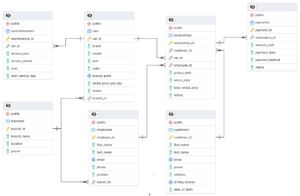Introduction to PostgreSQL: Features and Benefits

Introduction
PostgreSQL is a powerful, open-source relational database management system (RDBMS) that has been widely adopted by developers, businesses, and enterprises worldwide. Known for its robustness, extensibility, and compliance with SQL standards, PostgreSQL is an ideal choice for modern applications. This article explores PostgreSQL’s key features and benefits, highlighting why it is a preferred database solution.
What is PostgreSQL?
PostgreSQL, often referred to as Postgres, is an advanced, enterprise-class database system that has been in active development for over 30 years. It is renowned for its reliability, feature richness, and ability to handle complex queries efficiently. PostgreSQL is free to use and is supported by a strong community of developers and contributors.
Key Features of PostgreSQL
- Open-Source and Free: PostgreSQL is completely open-source and does not require licensing fees, making it a cost-effective choice for businesses of all sizes.
- ACID Compliance: PostgreSQL ensures data integrity by adhering to Atomicity, Consistency, Isolation, and Durability (ACID) principles.
- Extensibility: Users can define their own data types, functions, and operators, making PostgreSQL highly flexible.
- Support for Advanced Data Types: PostgreSQL supports a wide range of data types, including JSON, XML, Hstore, and Geospatial data (PostGIS extension).
- MVCC (Multi-Version Concurrency Control): This feature enhances performance by allowing multiple transactions to occur simultaneously without conflicts.
- Replication and High Availability: PostgreSQL supports streaming replication and logical replication for fault tolerance and load balancing.
- Full-Text Search: Built-in full-text search capabilities allow efficient searching of large text-based datasets.
- Stored Procedures and Functions: PostgreSQL supports multiple procedural languages, such as PL/pgSQL, Python, and Perl.
- Security Features: PostgreSQL provides robust authentication methods, including SSL encryption, role-based access control (RBAC), and auditing tools.
- Cross-Platform Compatibility: It runs on various operating systems, including Linux, Windows, and macOS.
- Parallel Query Execution: PostgreSQL supports parallel query execution, significantly improving performance on large datasets.
- Foreign Data Wrappers (FDW): This feature enables PostgreSQL to query and integrate data from external sources like MySQL, Oracle, and CSV files.
- Declarative Table Partitioning: PostgreSQL allows partitioning large tables for better query performance and data management.
- Event Triggers: It supports event triggers that help automate database operations based on certain actions.
- Temporal Tables: PostgreSQL supports historical tracking of data changes with temporal tables, making it useful for audit logging and data versioning.
Benefits of Using PostgreSQL
- High Performance: Optimized indexing, caching, and query execution plans ensure efficient data processing.
- Scalability: PostgreSQL handles large-scale applications with millions of transactions efficiently.
- Strong Community Support: The active PostgreSQL community provides continuous updates, security patches, and extensive documentation.
- Reliability and Stability: With over three decades of development, PostgreSQL is trusted by enterprises for mission-critical applications.
- Flexibility and Customization: The ability to extend PostgreSQL with custom functions and modules makes it adaptable for diverse use cases.
- Cost-Effective: Being open-source, PostgreSQL reduces overall software licensing costs compared to proprietary databases.
- Seamless Integration: PostgreSQL integrates well with modern tools, frameworks, and cloud services like AWS RDS, Google Cloud SQL, and Kubernetes.
- Data Integrity and Concurrency: The MVCC mechanism ensures that concurrent transactions do not interfere, maintaining database consistency.
Conclusion
PostgreSQL is a feature-rich, high-performance, and highly secure database solution that caters to businesses and developers alike. Whether you are building a small application or a large enterprise system, PostgreSQL’s reliability, scalability, and extensibility make it a top choice.
Stay tuned for more PostgreSQL tutorials, where we dive deeper into installation, configuration, and advanced database management techniques!
